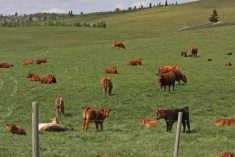Not all animal manure is created equal when it comes to nutrient values, says a nutrient management specialist.
Trevor Wallace of Alberta Agriculture said producers can increase the amount of value they obtain from manure by knowing more about the resource, whether they use it as a nutrient source or soil conditioner.
Value may be in the form of improved crop yield, reduced fertilizer requirements or better soil quality.
“To make the best nutrient management decision, you should know the moisture and nutrient content of the manure, soil nutrient and organic matter levels of the field and the crop’s fertility requirements,” Wallace said.
Read Also

Livestock leads Canada’s farm economic outlook
Forecasts by a major Canadian farm lender featured good and bad news on the financial health of both farmers and Canadians at large.
“This information will help you determine how, when and where the manure will be best utilized to get the most benefit from the available resources.”
Manure is a mixture of water, organic matter, mineral matter, microbes, nutrients and other chemicals. It is important to understand its composition, whether it be in solid or liquid form.
Manure nutrient composition varies widely between farms. Differences in animal type, age, diet, bedding materials, storage and handling will affect its characteristics.
Wallace said book values may not reflect the nutrient composition of individual farms, and sampling and lab analysis is the only way to get reliable nutrient content data. Several facilities on the Prairies can do this work.
He said nutrient content can vary within a solid manure pile, which can be addressed by using proper sampling procedures.
The nutrient content of liquid manure can also vary because of solids settling over time.
Proper sampling procedures analyzed over three to five years should provide adequate information to develop reliable estimates of average manure nutrient content for an individual operation.
“As long as they don’t have any significant changes in the system with their livestock or feeding type, it shouldn’t change,” he said.
Wallace said some producers previously viewed manure as a waste product. However, rising production costs and the high cost of commercial fertilizers have encouraged farmers to be more deliberate with their manure application and make more informed decisions.
“We were putting it out there and getting good yields, but now we’re being far more tactical with what we do,” he said.
“In the last six years, with the price of fertilizer, the phone rang off the hook when the price of phosphorus went up to a buck something a pound. I get more and more phone calls all the time, helping to calculate rates and what’s its value. It’s far more presence of mind than it used to be.”
However, other than feedlots, many producers who deal with solids are not sampling as much as those who use liquids. Thirty to 40 percent of producers who handle liquids are using lab services, while 10 percent or less are taking samples of solids.
Wallace said many are using book values of provincial nutrient content averages for manure.
“Some guys are putting it right on and sort of have a feel for it based on crop yield,” he said.
“Others are using last year’s crop as their metric for deciding this year’s manure application rate. It’s just two different ways of looking at it.”
Wallace said it’s important to remember that a feeding program can influence nutrient content.
“Seventy to 90 percent of the nutrients come out the back end, depending on the nutrient,” he said.
“If you look at any of the animals in high-end production, they’re given high protein, high nutritious feed. A lot of that ends up being high nitrogen manure. An animal that needs seven percent protein to live, and we feed them 12, that five percent is not going to make them live better.… It’s going to come out the back end.”
Calculators and spreadsheets are available online to help producers determine where to put manure so it has the best value. More calculators are being developed as apps.
These programs are designed to allow farmers, ranchers and producers to measure the amount of manure that is spread, calculate its nutrient content, account for transportation and estimate the amount of money saved by using manure rather than traditional chemical nutrients.
“You put your manure sample in and it will tell you how much nitrogen-phosphorus-potassium you’re putting on based on a rate you put in,” he said.
Nutrient management handbooks and planning guides are also available.
Contact william.dekay@producer.com















